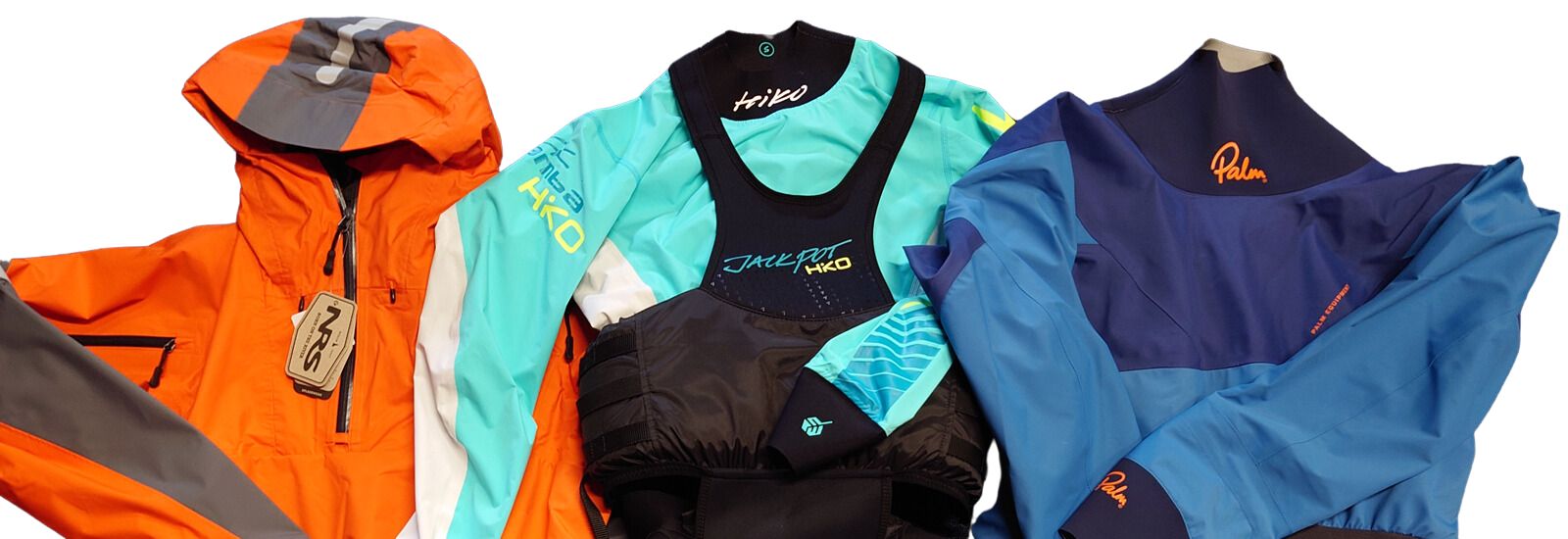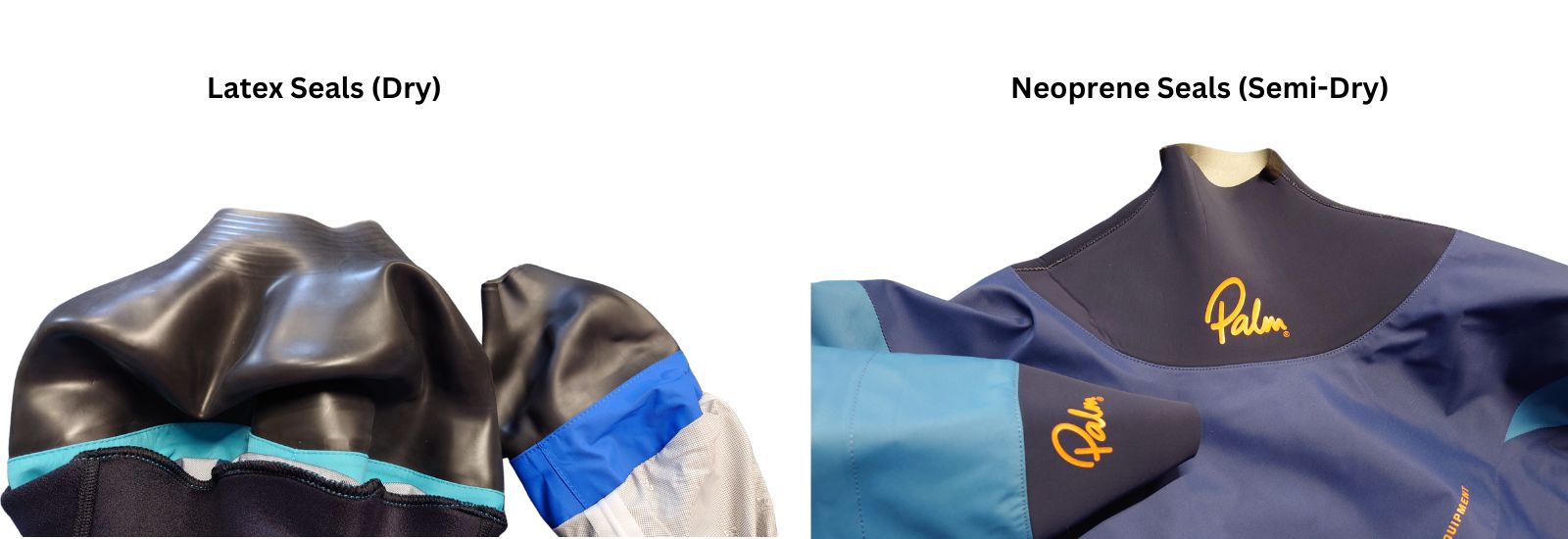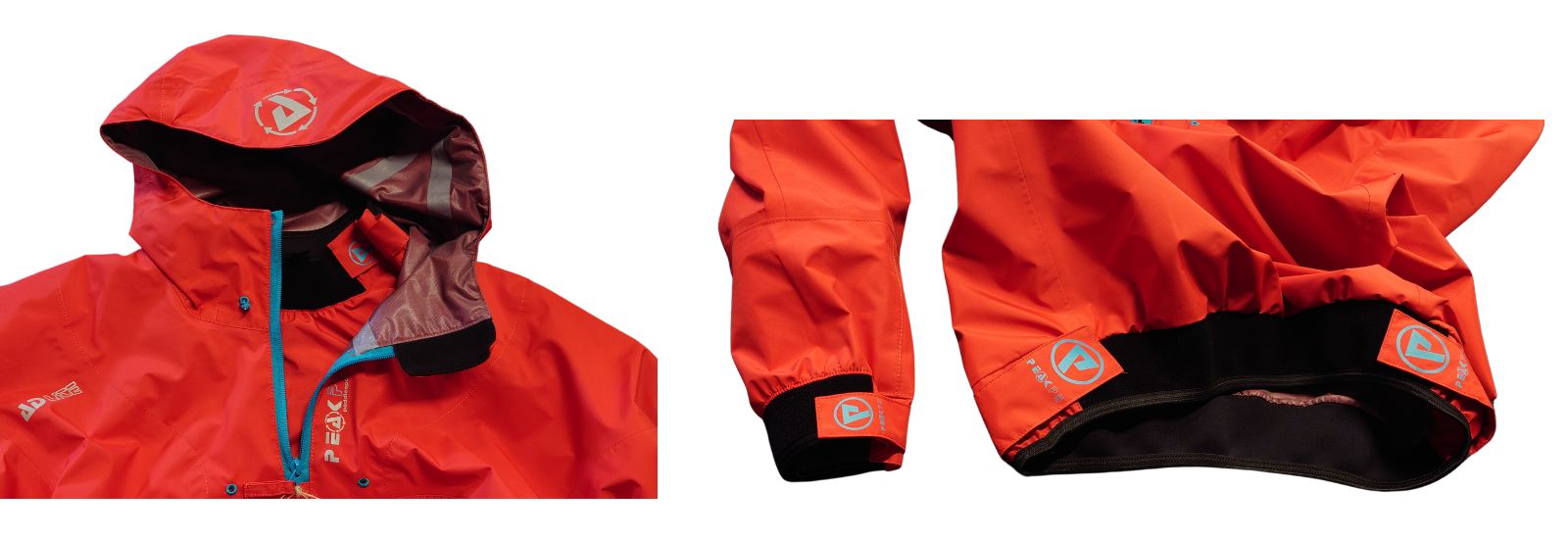Cags create a shell or protective layer between you and the outside world helping keep you dry, trap heat and reduce wind chill in order to keep you happier on the water and paddling for longer!
We have a range of cags from the leading paddle sports specialists including Kokatat, Hiko, Peak PS, NRS, and Palm Equipment suitable for Whitewater, Touring/Recreation and Competition paddling.
Known by a variety of different names cags, cagoules, dry tops and spray jackets...nowadays you can find a huge range designed specifically for paddle sport activities. Paddling cags tend to be shorter in the body than a normal jacket as you spend the majority of the time sitting down in it, and most will have some form of ‘pre-bent’ or articulated cut in the arm to help make the jacket as unrestricted as possible while paddling.
Cags are designed for quite a specific type of paddling and generally you can separate them into 3 different groups; Whitewater, Touring/Recreational and Competition. Features differ greatly so finding one cag suitable for everything can be a bit tricky.

What are you going to be using it for?
The type of paddling, the paddling environment and prevailing conditions are the first things to consider when looking for a cag. How wet are you going to get? What is the weather doing? How hard am I going to be paddling?
Whitewater jackets are designed for use on fast moving water where you can expect to be getting very wet. To keep you as dry and warm as possible in these kinds of environments, these jackets will normally feature a tight latex (referred to as ‘dry’) or neoprene seals (semi-dry) around the neck and wrists. Often the more delicate primary seal will be protected by a secondary seal.

You will also commonly find a twin waist tube designed to work with your spray deck waist tube and be constructed from mid-weight or heavier weight fabrics often with additional reinforcement on high wear areas like the elbows.
Touring/Recreational jackets are designed for calmer inland waters or the sea. Constructed from light-weight or mid-weight waterproof materials typically you’ll find they have more comfortable looser seals around the neck and wrists although some will have latex wrist seals. Generally featuring either a Velcro or zipped collar (sometimes both) and Velcro adjustable wrist seals to allow for ventilation and to make it easier to get the cag on and off. While these seals don’t keep out the water as well as the ones on a white water cag they will cope with spray, rain and wind really well. You will also find features like hoods, pockets and reflective elements relatively common.

Competition cags such as used for Slalom paddling share many of the same features of a white water cag but tend to be closer fitting, made from light-weight fabrics and mainly only feature a ‘semi-dry’ neoprene neck seal. In order to reduce the overall weight and amount of restrictive layers a paddler has to wear, these cags will, typically, be a ‘cagdeck’ or ‘topdeck’ design with a spraydeck sewn directly into the cag.

What features do you want your cag to have?
If you know where you’re going to be using your cag the next step is to think about the different features and what they mean. The following are common to all cags and make a big difference in terms of comfort, performance and cost.
Latex Seals
Used on neck and wrist seals a latex gasket is the driest type of seal available providing a good seal even when fully immersed in the water so great for white water paddling. It is not going to keep you 100% dry but its close! The stretchy rubber material forms a tight seal against your skin. This can make it difficult to get on and off and until the latex stretches a bit it can feel a little uncomfortable, and make your face especially go a bit red!
The latex seals on any top, these are not normally covered by the warranty, are only glued in and being made from a natural rubber they will perish or split over time. While you can get them replaced we recommend you look after them! The other thing to remember is latex seals don’t allow any adjustment or ventilation to help you control your temperature and so you won’t find many touring jackets with this type of neck seal, although some might have a latex wrist seal.
Neoprene Seals
Used on neck and wrist seals. Neoprene seals vary in performance but can provide a much more comfortable seal while still keeping you relatively dry. A popular alternative for people not comfortable or allergic to latex and usually slightly cheaper as well, also while still quite fragile they won’t perish in the same way a latex gasket will.
They work by creating a close fitting seal around the neck and wrist, so again limit any adjustment and ventilation.
Adjustable Seals
Found mostly on recreation and touring cags. These help keep the cag comfortable in a range of conditions by allowing you to have them wide open for ventilation or done up tight to keep the elements out. While they will never be able to keep you as dry as a latex gasket, they are very useful in changeable conditions or to manage you’re temperature as the paddling starts to warm you up!
Adjustment is typically done using a Velcro tab system or a zip. In some case these are combined to create a twin neck seal. Made from a range of materials such a PU, neoprene or in some cases fleece lined! Some cags will also have a way of securing any 'flaps' while the neck seal is open.
Twin Waist
Found on whitewater and more expensive touring cags. A twin waist is designed to be layered up with the waist tube to prevent water getting into your boat and keep you drier. An elasticated inner is typically covered by a second waist tube which will have a fastening system to help provide a good fit.
While this will keep you drier it will make the cag heavier, warmer and mean more bulk around your middle.
Materials
Manufactures will refer to different weight materials as having different layers 2, 2.5, 3 etc. The more layers, the warmer and generally tougher the fabric is, as well as being more expensive. Some cags will have an additional layer of tougher material on areas of the cag that are more exposed to wear, such as the elbow or forearm. These improve the durability, but will add weight and can reduce the fabric's breathability. It's worth remembering that you can use a lighter weight cag all year round with a good set of thermals!
All materials will, to some extent, be breathable which is important to help manage any moisture inside the cag but not all are created equal in this respect. Check the manufacturer’s information to find out more about their fabrics performance. More durable, breathable materials will generally be more expensive but lightweight materials can still be a good option to keep showers and the wind off.
Sizing
Finally there isn’t a ‘standard’ medium size used in the paddle sport industry; everyone makes a cag that fits slightly differently. We recommend trying them on, if this is your first cag or the first time buying a particular brand, before purchasing to make sure your happy with the fit!